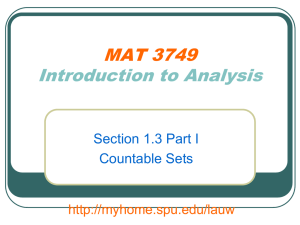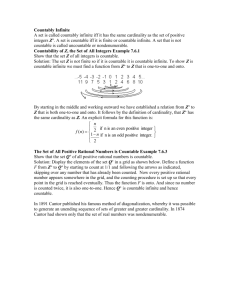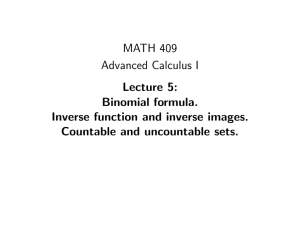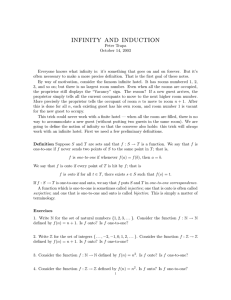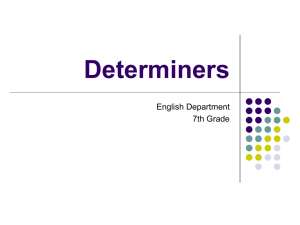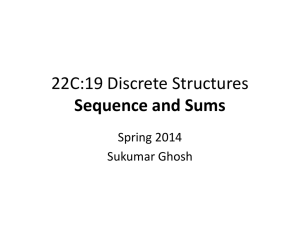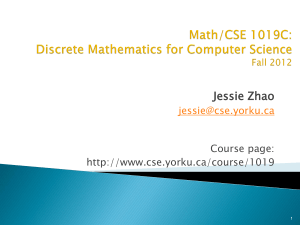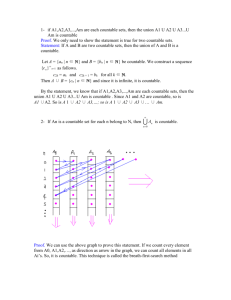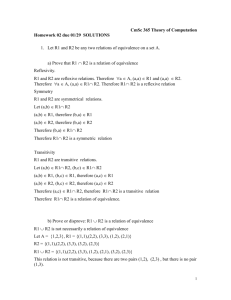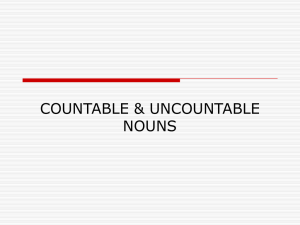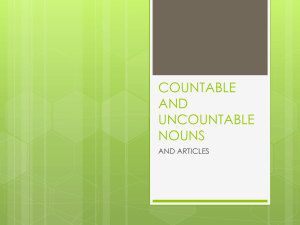Class notes Sept. 13
advertisement
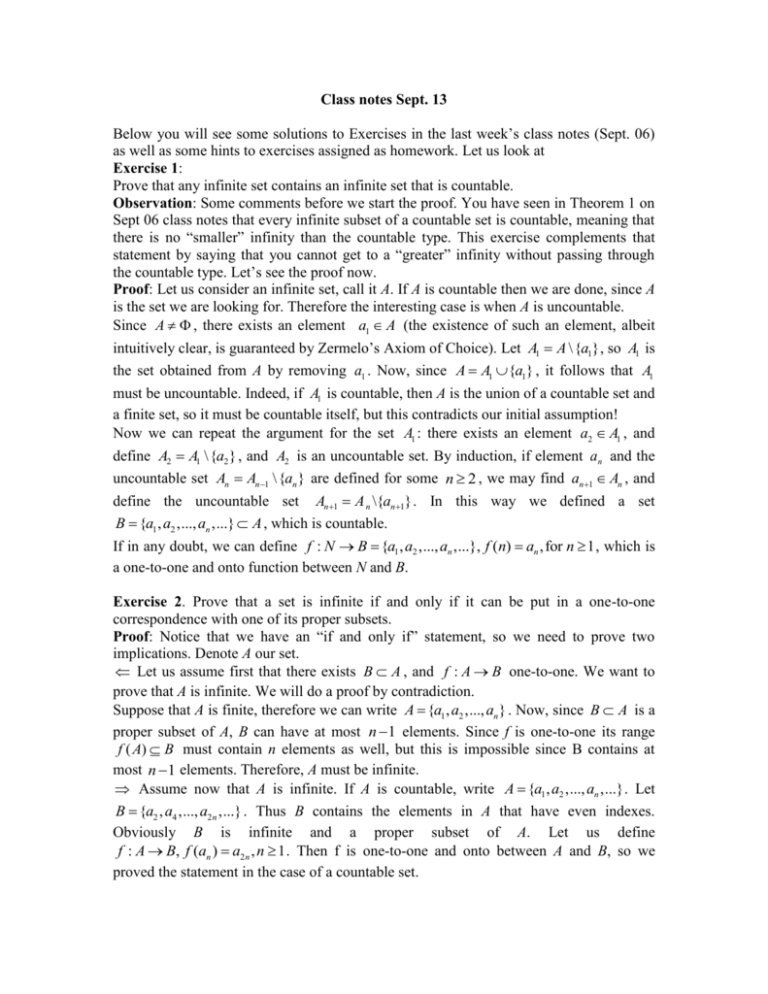
Class notes Sept. 13
Below you will see some solutions to Exercises in the last week’s class notes (Sept. 06)
as well as some hints to exercises assigned as homework. Let us look at
Exercise 1:
Prove that any infinite set contains an infinite set that is countable.
Observation: Some comments before we start the proof. You have seen in Theorem 1 on
Sept 06 class notes that every infinite subset of a countable set is countable, meaning that
there is no “smaller” infinity than the countable type. This exercise complements that
statement by saying that you cannot get to a “greater” infinity without passing through
the countable type. Let’s see the proof now.
Proof: Let us consider an infinite set, call it A. If A is countable then we are done, since A
is the set we are looking for. Therefore the interesting case is when A is uncountable.
Since A , there exists an element a1 A (the existence of such an element, albeit
intuitively clear, is guaranteed by Zermelo’s Axiom of Choice). Let A1 A \{a1} , so A1 is
the set obtained from A by removing a1 . Now, since A A1 {a1} , it follows that A1
must be uncountable. Indeed, if A1 is countable, then A is the union of a countable set and
a finite set, so it must be countable itself, but this contradicts our initial assumption!
Now we can repeat the argument for the set A1 : there exists an element a2 A1 , and
define A2 A1 \{a2 } , and A2 is an uncountable set. By induction, if element an and the
uncountable set An An1 \{an } are defined for some n 2 , we may find an 1 An , and
define the uncountable set An1 A n \{an1} . In this way we defined a set
B {a1 , a2 ,..., an ,...} A , which is countable.
If in any doubt, we can define f : N B {a1 , a2 ,..., an ,...}, f (n) an ,for n 1 , which is
a one-to-one and onto function between N and B.
Exercise 2. Prove that a set is infinite if and only if it can be put in a one-to-one
correspondence with one of its proper subsets.
Proof: Notice that we have an “if and only if” statement, so we need to prove two
implications. Denote A our set.
Let us assume first that there exists B A , and f : A B one-to-one. We want to
prove that A is infinite. We will do a proof by contradiction.
Suppose that A is finite, therefore we can write A {a1 , a2 ,..., an } . Now, since B A is a
proper subset of A, B can have at most n 1 elements. Since f is one-to-one its range
f ( A) B must contain n elements as well, but this is impossible since B contains at
most n 1 elements. Therefore, A must be infinite.
Assume now that A is infinite. If A is countable, write A {a1 , a2 ,..., an ,...} . Let
B {a2 , a4 ,..., a2 n ,...} . Thus B contains the elements in A that have even indexes.
Obviously B is infinite and a proper subset of A. Let us define
f : A B, f (an ) a2 n , n 1 . Then f is one-to-one and onto between A and B, so we
proved the statement in the case of a countable set.
Let us assume now that A is uncountable. As seen in the previous exercise, A contains a
countable subset; let us denote it by {a1 , a2 ,..., an ,...} , and define B A \{a1} . We define
f : A B, f (a) a, for a an , n 1, and f (an ) an1 for n 1. It can be easily checked
that f is one-to-one, and the proof is finished.
In what follows you will find some hints on the Hw problems due Wed., Sept. 20.
Exercise 9 (class notes Sept. 06). Show that if A B, then P( A) ~ P( B) .
Since we know that A B , then there exists a one-to-one and onto function f : A B .
We want to define a one-to-one and onto function g : P( A) P( B) . Note that the
elements of P( A), P ( B ) are subsets of A and B, respectively. Define g ( E ) f ( E ) , where
f ( E ) { f ( x) : x E} is the image of E. You need to prove that g defined as above is
one-to-one and onto. Make sure you use the hypotheses that f is one-to-one and onto.
Here are some examples to clarify the definition. Let f :[1,1] R, f ( x) 2 x 1 . Then
the range of the function is f ([1,1]) [1,3] .
If we take for example the set E [0, 0.5], then f ( E ) [1, 2] .
You will also need in this exercise to work with the preimage of a set by a given function.
See definition in Abbott (page 12, ex. 1.2.7). Here is the definition.
Let f : A B , and let F B . We define the preimage of the set F,
f 1 ( F ) {x A : f ( x) F} . Notice that f need not have an inverse for this definition.
For example, let f :[2, 2] R, f ( x) x 2 , and let F [1, 4] R . We have
f 1 ( F ) [2, 1] [1, 2] . Also if we want to find f 1 ({2, 4,9}) { 2, 2} , so it is
nothing wrong to have elements in F which do not belong to the range of the function.
Their preimage is empty, that is f 1 ({9}) .
